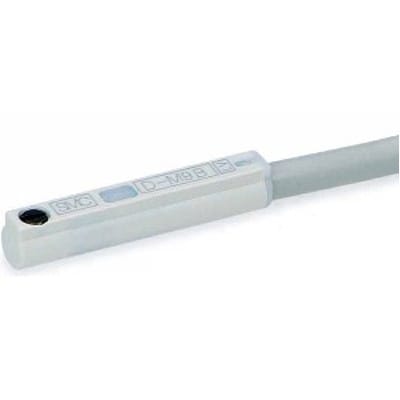SMC Corporation D-F5PZ
Solid State Pneumatic Position Detector, IP67
Mfr. Part #: D-F5PZ / RS Stock #: 70274090

Image may be a representation. See specs for product details.
Price
Qty.
Standard Price
1
$44.06
Product Specifications
Product Attribute
Attribute Value
Search
Body Style
Rectangular
Connector Type
Grommet
For Use With
NCA1
IP Rating
IP67
Leads
5.0 m
Mounting Type
Surface Mount
Output Type
PNP
Primary Type
Proximity
Supply Voltage
4.5 to 28 VDC
Termination
3-Wire
Type
Solid State Auto Switch
Overview
One type of proximity switch is an enclosed reed switch that is activated by a permanent magnet mounted to the piston. As the piston approaches, the magnetic field closes the switch, completing an electric circuit and producing an electric signal. Others prefer to use Hall-effect (Solid-State) sensors in combination with a piston-mounted magnet. The main difference between these two devices is that a reed switch is a mechanical device, while a Hall-effect (Solid-State) switch is electronic, with no moving parts to wear out. Reed switches have the advantage of operating on AC or DC current; Hall-effect (Solid-State) switches are limited to DC only. Also, reed switches are about half the price of their electronic counterpart, although the price differential is decreasing. On the other hand, Hall-effect (Solid-State) devices react much faster than reed switches, on the order of 100,000 versus 500 Hz. It is a waste of money to install microprocessor-based logic, and then be hampered by a slow switch. Overall, the trend seems to be towards these solid-state devices. Both switches have a repeatability of 0.005" or less. But often rod velocity, not switch accuracy, determines the overall repeatability of rod position. Because air is a compressible fluid, precise positioning of the cylinder rod -- especially in midstroke -- is difficult, regardless of the switch used. In many applications, even if the switch is very fast and accurate, getting the valves to react fast enough may be the real problem. In such cases, mounting fast-acting valves as close to the cylinder as possible is important. This eliminates excess compressible air in the lines between cylinder and flow control, giving more precise control. Note: Switch mounting hardware sold separately.







 Bulk pricing available
Bulk pricing available
